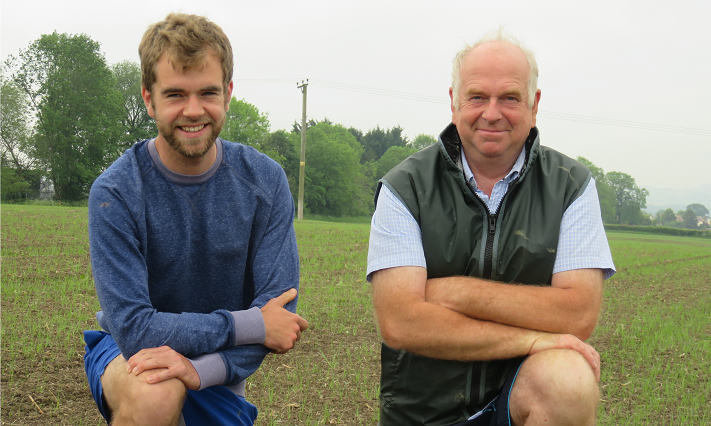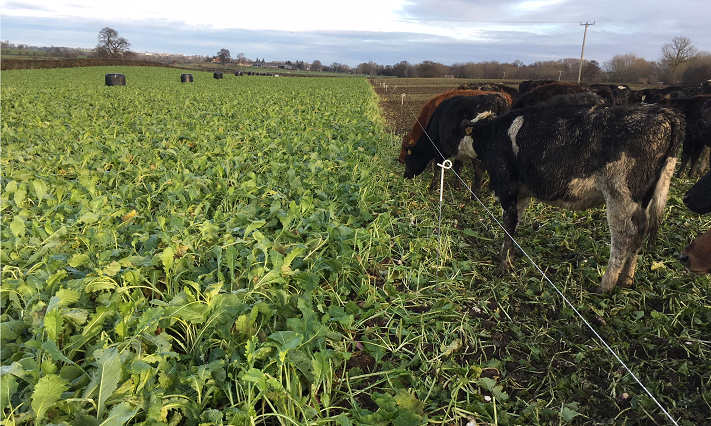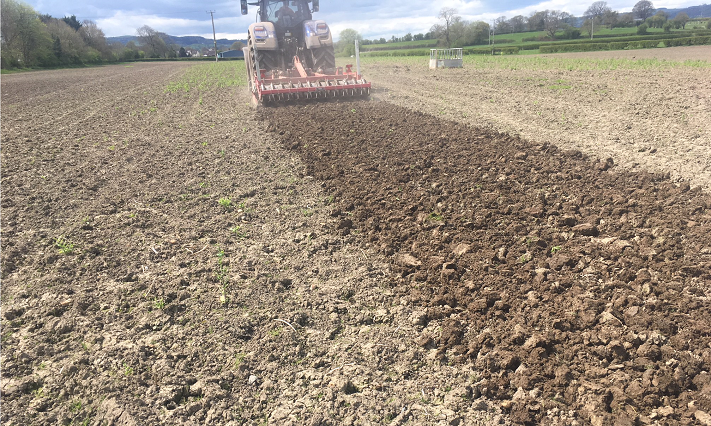Preparing well to reseed
Using a forage break crop ensures no carry over of pests such as frit flies between the old and new swards
Neale and his son Dan Manning run a New Zealand-style, low-cost dairy system at Malehurst Farm, Minsterley in Shropshire.
With 90ha (220 acres) of ring-fenced land with cow tracks to almost all paddocks, the fields were reclaimed from marsh 130 years ago and currently lie a few feet below the level of brooks that run across the farm, so flooding can be a problem.
The philosophy is to produce as much milk from grazed grass as possible from 230 spring-calved crossbred cows. They went out this year on 16 February, two weeks later than usual, and were re-housed when the snow was falling. They will stay out until the end of November. The last cows are dried off on 22 December and the first start calving at the beginning of February.
The cows are given fresh grazing every 12 hours behind an electric fence. Paddocks are pre-mowed if they are starting to head to maintain nutritional quality at its highest level.
With milk yields averaging 5,300 litres, milk from forage currently stands at 3,800 litres (72%) and most of this is from grazed grass, from a stocking rate of 3.6 cows/ha. Last year the cows were fed 700kg of high-energy concentrate over their lactation, depending on the amount and quality of the grass they were grazing. The milk is sold to Arla.
“The cows are here to do just one job,” says Neale. “That is to turn grass into milk into money. We play to our strengths – we grow a lot of high quality grazing grass, and silage is cut purely to maintain the conveyor belt of consistent high quality grass for the cows to eat.
“Grass that is growing in May when eaten gives 20 litres of milk in the tank. That same May grass eaten in December as silage, will only give half that – so it is better to be eaten fresh in May. We buy in 100 tonnes of hay and 100 tonnes of silage, which supplements the silage we make from the surplus grazing.”
Sending heifers off to be contract reared for the first time this season will release enough land to increase cow numbers up to 270 next year, and has also given the opportunity to reseed two fields that have fallen behind in performance.
“Last year was a phenomenal grass growing year,” says Dan. “I took 32 platemeter measurements from February to November and averaged 16t DM/ha with 212kg/ha of nitrogen fertiliser. Fields ‘Near 9’ and ‘The Grove’ were falling behind the rest, so these are the ones we have reseeded. And it won’t be long before they come back into the rotation.”
The Grove
The Grove is 4.4has (11 acres) and is the farthest field from the farm buildings and was drilled with Autumn Feed – a mixture of Winfred forage rape, two stubble turnip varieties and kale on 18 August last year.
Fifty-two, 250kg heifers grazed this with a bale of silage a day over 56 days. The field was double-fenced down the sides and at the front as breakouts ruin the quality of the crop for following days. The heifers grazed until 1 February and the field was left fallow.
This use of a forage break crop ensures no carry over of pests such as frit flies between the old and new swards.
On the 4 May a Sumo subsoiler, power harrow and roller combination was drawn through the soil.
The alluvial/clay soil was still too cloddy to drill grass seed into, so it was power harrowed once more and rolled on 5 May.
Claymore, an Oliver Seeds mixture containing intermediate and late perennial ryegrasses, timothy and white clover was sown and immediately rolled.
Claymore is an adaptable mixture, which has good spring growth and hardiness and exceptional performance under intensive grazing management. It is ideal for cutting for silage, as the Grove is more likely to be harvested for winter forage than the closer fields, but it does also provide good grazing. It has good disease resistance.
The first leaves appeared on the 16 May and the field was getting good coverage by the 29 May. Annual seedlings of red shank will disappear after the first cut, which the Mannings hope to take in the first week of July.
Near 9 acres
The Near 9 acre field has undergone a transformation over the past six months. The field has been drained, the ditches dredged and boundary trees coppiced. It was full of unproductive grasses and was too wet to let the cows graze in spring.
The field can still flood – as seen on Sunday 27 May. But, due to the remedial work carried out, two days later the water had all drained away.
The field was sprayed off with glyphosate on 17 April 2018, a month later than expected.
First a contractor ploughed the field before it was power-harrowed with a grass seeder on top of it on 11 May. Finally it was rolled.
The seeds mixture was Oliver Seeds Century, a medium to long term grazing ley consisting of five late heading perennial ryegrasses and timothy. It has consistent production throughout the season and is highly palatable. Surplus growth makes good silage and it has a yield potential of 17t DM/ha. It is persistent and winter hardy and gives years of reliable output. It was drilled at 14kg/acre.
The completed seedbed was fine, firm, level and consistent across the field
On 27 May the seed was germinating and could be easily seen. It will be grazed once the field reaches 2,500kg DM/ha and the Mannings expect to get at least five grazings from it this year.
Cost of reseeding/ha
| |
Near 9
(Had slurry application) |
The Grove
(Had muck application) |
| Investment in drainage and coppicing |
£3,461 |
|
| Cultivation/establishment of Autumn Feed |
|
£112 |
| |
|
|
| Sward Destruction |
£15 |
|
| Cultivations and Drilling |
£188 |
£176 |
| Seeds Mixture |
£136 |
£140 |
| Cost of red=seeding new sward |
£339 |
£428 |
Neale and Dan pay close attention to detail when it comes to the preparations to reseed to ensure good establishment.
“We take great care of every element of reseeding,” says Dan. “First we make sure the soil is free-draining and not panned, we check the pH is right and the phosphate and potash levels are good. Everything has to be in balance.”
The team at Oliver Seeds has a checklist that all farmers should go through before getting the drill out.
- Walk the fields and identify the poorest performers. Use growth figures if possible, to decide which ones to reseed
- Do a sward assessment to see which grasses are growing. Is there much ryegrass left or are there a lot of unproductive plants like annual meadow grass?
- Assess how many weeds are growing. Are they tough perennial weeds like docks or annual weeds like chickweed? If they need treating, decide what products to use and book the contractor if the farmer is not certified to spray herbicides
- Keep soil testing. Aim to do a quarter of the farm each year and apply P, K and Mg fertiliser according to the results
- Dig a soil pit and check for compaction, as grass will not grow well if it cannot get its roots down deep into the soil. Alleviate any tight areas with appropriate machinery, as long as conditions are not too wet
- Check the field drains are working and mend if broken
- Select the right seeds mixture and method of reseeding
This article first appeared in the July 2018 issue of Dairy Farmer.



